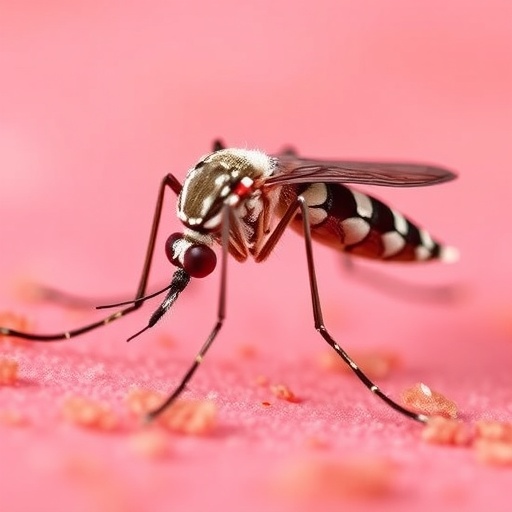Two of the world’s most lethal mosquito vectors, Aedes aegypti and Anopheles funestus, have undergone complex evolutionary trajectories shaped by human activity that are now presenting formidable challenges to global disease control efforts. Recent genomic studies exploring their origins, dispersal, and adaptive mutations provide unprecedented insights into the ways these species have evolved in tandem with humanity, fueling the spread of diseases such as dengue and malaria. These investigations highlight not only how anthropogenic factors have propelled their global distribution but also underscore the pressing need for nuanced and innovative strategies to curb their impact.
The invasive success of Aedes aegypti, a mosquito responsible for transmitting dengue, chikungunya, and Zika viruses, has long perplexed scientists, with its precise origins debated for decades. Researchers led by Jacob Crawford have addressed this uncertainty by sequencing over 1200 genomes from 73 populations worldwide. Through detailed coalescent and phylogenetic analyses, their work disentangles ancient dispersal events from recent migrations, revealing a complex history driven largely by human activity. Notably, the lineage of Ae. aegypti that dominates globally today appears to have originated in the Americas, following an initial adaptation to human hosts in West Africa.
This evolutionary pathway is intimately tied to historical human trade routes, particularly the Atlantic slave trade, which facilitated the initial translocation of Ae. aegypti mosquitoes from Africa to the New World. The resulting invasive lineage established itself firmly in the Americas before making a reverse migration back to Africa in more recent times. This backflow has had significant epidemiological consequences, as interbreeding between invasive and native populations has coincided with increased dengue outbreaks and the spread of adaptive insecticide resistance mutations, complicating control efforts.
In stark contrast to Ae. aegypti, Anopheles funestus remains one of the primary vectors of malaria across Africa, a continent where the disease incurs enormous public health burdens. The team led by Marilou Boddé embarked on an ambitious project, sequencing 701 modern and historical mosquito specimens collected over the last century from 16 African nations. This longitudinal genomic analysis has illuminated the dynamic population structure of An. funestus, revealing both finely localized genetic differentiation and surprisingly broad genetic connectivity between distant populations.
The geographic structuring discovered in An. funestus populations indicates the existence of distinct evolutionary lineages, notably in northern Ghana and southern Benin. This population stratification suggests that malaria control approaches cannot be uniformly applied across regions without risking failure. Instead, these findings advocate for the design and deployment of tailored vector control measures that address the genetic and ecological specificities of local mosquito populations.
Moreover, the study underscores a worrying trend: the rapid and multifaceted emergence of insecticide resistance within An. funestus populations. By comparing recent specimens against museum samples dating as far back as 1967, Boddé and colleagues demonstrate that most resistance-conferring alleles have appeared relatively recently. These adaptations have arisen via both independent, de novo mutations and the spread of pre-existing resistant genetic variants across the continent. This genetic plasticity threatens to undermine the efficacy of conventional vector control tools, such as insecticide-treated nets and indoor residual spraying.
Beyond describing population diversity and resistance mechanisms, the An. funestus genomic investigation also identifies promising molecular targets for gene drive technologies. These emerging biotechnological tools aim to propagate specified genetic traits through mosquito populations, offering a potential game-changer in the fight against malaria. However, the complex population structure revealed by this study highlights the critical importance of accounting for regional differences when designing and deploying gene drive strategies to avoid unintended consequences and enhance field efficacy.
Together, these two studies markedly advance our understanding of how mosquito vectors linked to two major worldwide diseases have co-evolved with human populations and exploited anthropogenic factors such as global trade and insecticide use. The findings emphasize the urgent need for more granular, genome-informed interventions tailored to the ecological and genetic realities on the ground. With mosquito vectors rapidly adapting to changing environments and control pressures, static or one-size-fits-all public health measures risk obsolescence.
Tamar Carter, writing in an accompanying Perspective, encapsulates the broader implications by noting that human activities—both passive transport and active intervention—have shaped the movement and adaptation of these vectors in ways that generate complex genomic diversity. This complexity likely maps onto functional traits relevant for disease transmission and insecticide resistance, which remain to be fully understood. Advancing this functional genomics frontier will be pivotal in forecasting vector responses and optimizing control interventions.
Further adding context to the ongoing global dengue challenge, a recent August 2025 study by Quandelacy et al. in Science Translational Medicine provides an incisive analysis of dengue transmission dynamics across the Americas. Their work elucidates how regional outbreak patterns are intricately modulated by climatic variables, complementing the evolutionary insights offered by the genomic studies. This convergence of genomic and epidemiological data is vital for crafting comprehensive, adaptive control measures resilient to environmental and vector evolutionary change.
In sum, these groundbreaking investigations into Ae. aegypti and An. funestus genomics redefine our understanding of vector biology and disease transmission. They highlight the indelible imprint of human history and behavior on vector evolution while issuing a clarion call for precision-driven, innovative vector control frameworks. Failure to heed these genomic insights risks prolonging the global public health toll exacted by vector-borne diseases.
As the battle against mosquito-borne illnesses intensifies, integrating high-resolution genomic surveillance with ecological and epidemiological monitoring emerges as an indispensable pillar of modern public health strategy. Tailoring interventions to local vector population structures, preemptively addressing emerging resistance mutations, and harnessing gene drive technologies responsibly could collectively turn the tide in global efforts to suppress malaria, dengue, and other mosquito-transmitted diseases. The path forward demands a holistic, adaptive approach founded on cutting-edge science and cross-disciplinary collaboration.
Subject of Research: Genomic evolution, spread, and insecticide resistance in Aedes aegypti and Anopheles funestus mosquito vectors.
Article Title: 1206 genomes reveal origin and movement of Aedes aegypti driving increased dengue risk
News Publication Date: 18-Sep-2025
Web References:
10.1126/science.ads3732




